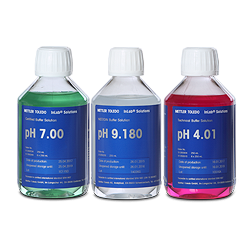Buffers are aqueous systems that resist changes in pH when small amounts of acid or base are added and are composed of a weak acid and its conjugate base. A buffer keeps the pH of a solution constant by absorbing protons that are released during reactions or by releasing protons when they are consumed by reactions. The discovery that partially neutralized solutions of weak acids or bases are resistant to changes in pH, when small amounts of strong acids or bases are added, led to the concept of the ‘buffer’.
A conjugate base is an acid that has lost a proton.
HA ↔ H+ + A-
Acid ↔ proton + conjugate base
A conjugate acid is a base that has gained a proton.
A + H+ ↔ H+A
Base + proton ↔ conjugate acid
An equilibrium between the dissociated and undissociated form is established.
For example, weak acetic acid partially dissociates in water producing an acetate ion:
CH3COOH ↔ H+ + CH3COO-
The undissociated acetic acid, the hydrogen ions and the dissociated ion exist in equilibrium in solution.
Sodium acetate also dissociates in water to produce the same acetate ion:
CH3COONa ↔ Na+ + CH3COO-
The undissociated sodium acetate and the ions of sodium and acetate exist in equilibrium in solution.
An aqueous solution of a mixture of acetic acid and sodium acetate can therefore absorb H+ ions from the addition of an acid through the combining of the hydrogen ions with the acetate base to produce acetic acid. Furthermore, when OH- ions are introduced into the solution through the addition of an alkali, they combine with acid molecules (H+) to produce water. In this way, as the system attempts to restore the equilibrium, the solution resists changes to the pH value. This is how a buffer solution works.
What happens after adding acid to the buffer?
When some strong acid (more H+) is added to an equilibrium mixture of the weak acid and its conjugate base, the equilibrium is shifted to the left, in accordance with Le Chatelier’s principle.
What happens after adding a base to the buffer?
Similarly, if a strong base is added to the mixture, the hydrogen ion concentration decreases by less than the amount expected for the quantity of base added. This is because the reaction shifts to the right to accommodate for the loss of H+ in the reaction with the base.



















